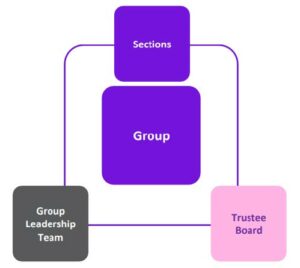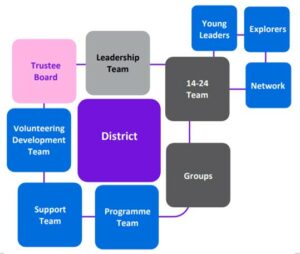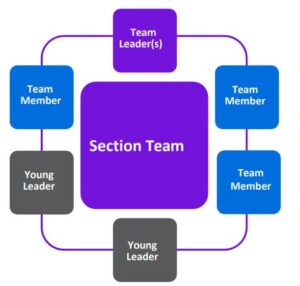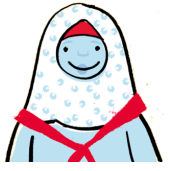Transforming Scouts - Simplifying volunteering
WHY ?
In the research undertaken across a wide range of volunteers over a period of time, we have learnt that:
- We have too many roles, which can be unmanageable, fixed and too often feel like work.
- They can be hard to understand, and expectations when someone joins or moves role are often unclear. They can put people off from joining as they may feel ‘I couldn’t do what you do.’
- We have a small number of people with lots of responsibility (and stress) placed on them. This can often make volunteering feel less like fun and more like an obligation.
- The digital systems which manage volunteers are inefficient and time consuming to use.

From...
To...
Individual, inflexible and fixed roles
Volunteers working in teams, on tasks with a clear purpose
Unclear expectations for new and current volunteers
Clearer roles with titles that people inside and outside of Scouting understand
A small number of people / roles with lots of responsibility and stress
Improved team structures with clearer responsibilities, new digital systems to reduce administration
Ineffective and time-consuming digital systems for volunteers
New digital easy-to-use systems to support volunteers and volunteer managers
Volunteering can feel like work
Structures and teams which allow for individuals to contribute in a way that matches their skills, interests and availibility
In addition, there have been significant changes in Charity Governance by all regulators over the past few years.
As part of this, Executive Committees will be changing to Trustee Boards. This is more than just a change of name. The Trustee Board will be focused on making sure the charity is well managed, risks are assessed and mitigated, buildings and equipment are in good working order, and everyone follows legal requirements and Policy, Organisation and Rules (POR).
Their support helps other volunteers run a fantastic programme that gives young people skills for life.
HOW?
We will move towards teams-based volunteering. And all volunteers will be part of a team. Some Sections, Units, Groups, Districts and Counties already volunteer in effective teams, but we want this to happen everywhere. We already know from local successes that people achieve more in teams.
- A team shares a Team Description, which gives a purpose, outcomes, and tasks for the team. This will be a mixture of tasks for the whole team and allocated tasks for a particular people that the team can agree on. These will replace the current Role Descriptions.
- A team can decide between themselves how to allocate the tasks to suit volunteers’ skills, interests, and availability. This makes flexible volunteering normal and available to everyone.
- Teams have team leaders. This could be one or more people, and they will coordinate the tasks with the team. • Our systems and processes will support volunteering in teams.
- As part of these changes, what we call our volunteer roles will change. Our role titles will be updated to reflect how we volunteer now.
- Updating role titles will also ensure they are understandable and appealing for new and current volunteers. Some named roles will be retained – where these serve clear purpose such as Treasurer or Permit Assessor.
The proposal
Following member feedback, consultations, and initial scoping a series of proposed structures and associated responsibilities have been formulated to allow us to plan and work within a Team Based Framework. (Click on images to enlarge them)
For our Sectional Teams, the structure will look like this, and each Section will have one or more Team Leaders. There will be a Team Description for the Section which identify, what the Team Leader(s) responsible for and what the whole Team is responsible for. The latter elements can be divided, shared, adapted as agreed within that team.
There will be no distinction between the current roles of Assistant Section Leader and Section Assistant, all will be Team Members. (Occasional Helpers do not appear in this structure as they are currently a Group resource).
GROUPS
 The Group embeds each Section into the following structure
The Group embeds each Section into the following structure
In addition, there will be a Group Leadership Team, which includes the Section Team Leaders and any other volunteers. This will be led by the person leading the Group, currently titled Group Scout Leader but it does not mean that all the things the Group should default to just one or two volunteers.
The Team Description will again identify the responsibilities of the Team Leader and those which can be shared amongst the team members. This allows the load to be spread and individuals able to support as best fits their skills and available time. Volunteers can be added to this team to fulfil its responsibilities and sub-teams can be created to fulfil specific tasks and responsibilities if appropriate. This may include a Group camp site, vehicle, equipment, or activities.
There is also a Trustee Board at Group Level, which provides governance to the Group. All members are trustees of the Group with the associated responsibilities, and these are fundamentally:
- Looking after the finances
- Ensure buildings and equipment are in good working order
- Managing risk and maintaining a risk register
- Ensure legal requirements are followed by everyone
With the change from Executive Committee to Trustee Board it is envisaged that the size of the body may be reduced to be fully effective in meeting these responsibilities. Some current members of an Executive Committee might, therefore, migrate to be part of the Leadership Team.
DISTRICT
 When it comes to our Districts, each Group forms a component part as is now. In addition, any section in the 14-24 range (Explorer Scout Units including Young Leader Units, Scout Network) together with some specialist teams as follows.
When it comes to our Districts, each Group forms a component part as is now. In addition, any section in the 14-24 range (Explorer Scout Units including Young Leader Units, Scout Network) together with some specialist teams as follows.
At District, the teams are split into five areas. There are brief summaries of each below. There will be a lot more detail in the individual Team Descriptions for each.
- Leadership Team – lead, inspire and motivate
- Trustee Board – provide governance (see Group Trustee Board, above for detail)
- Programme Team – bringing Section roles together/ with other activity experts, supporting Sections in Groups, coordinating District based events
- Volunteer Development Team – recruitment, appointments and ensuring our volunteers are well supported
- Support Team – keeping things running smoothly such as District campsite, incident management, record keeping, media and community involvement
There is also 14-24 Team at a District Level supporting Explorers and Network. The Team Leader also feeds into the District Leadership Team in the same way that the team leaders for group feed into the Leadership Team.
Transformation will see some changes in and removal of roles. Scouts has already agreed to the dropping of the title Commissioner at all levels so what we currently refer to as the “District Commissioner” will change to District Lead Volunteer. In addition, roles such as Assistant District Commissioner(ADC), District Leader, District Appointments Chair / Secretary/ Member will disappear as the individual functions will migrate into the teams i.e., ADC (Section) may become part of the Programme Team, Appointments team members may be part of the Volunteer Development Team etc.
In the same manner, current Scout Active Support Units could be sub teams according to their function. Examples would be Camp Site ASU becomes part of the Support Team; Archery / Shooting ASU becomes part of the Programme Team.
COUNTY
 The picture at County level is pretty similar to that at District with the omission of the 14-24 Team.
The picture at County level is pretty similar to that at District with the omission of the 14-24 Team.
The County teams will enhance the support provided to Scouting in a County. The Leadership Team will incorporate the County Volunteer Lead as well as each District Volunteer Lead. In the same manner as District level, Assistant County Commissioners (ACC), County Appointments Team members and any Scout Active Support Units will be brought into respective Teams.
In addition, the changes in training will result in several roles disappearing such as County Training Manager, Local Training Manager and Training Adviser. The tasks and responsibilities for these roles will shift into the Volunteering Development Teams at County and District levels.
What will stay the same
Our structures will still be arranged in Sections, Groups, Districts and Counties, as well as broadly the tasks that happen at each level. For example, Section Teams will still deliver programmes to young people.
Even if our structures look different, you should still be able to volunteer in the area that is of most interesting to you, such as working with young people, delivering excellent governance, or giving support to other volunteers.
WHEN?
The changes and new Team Descriptions are still being refined and developed. Then there will be an extensive period of testing using pilot Districts and Groups across the UK to ensure that the new approach and systems are “fit for purpose.”
Whilst some of these changes can be adopted locally once these descriptions are finalised, the change in structures, role titles and reporting are tied to the delivery of the new membership system which is not expected to be operational until towards the end of 2023.
WHAT NEXT?
Sections, Groups, District, and the County may already be working along some of these proposals so there is no need to stop and change. At Group level, initial conversations with new and existing members, maybe when undertaking an initial meeting or a review should introduce the planned changes within the next 12 months so that individuals are aware of how these changes might affect them.
At District and County, consider looking for an ADC/ACC (Activities) or ADC/ACC (Programme) rather than by Section to incorporate the flexibility now.
The same considerations if looking to recruit / replace volunteers working with Appointments or Training so that they are aware that the current role will, in the existing format, have limited timeframe and outline changes ahead.


